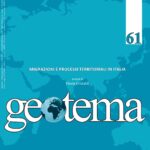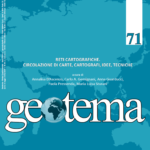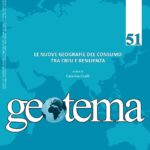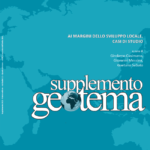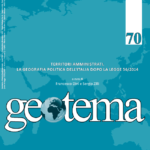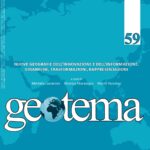Giuseppe Terranova
Cause e conseguenze territoriali della distribuzione spaziale degli immigrati nelle aree metropolitane. La particolarità del caso italiano
La pluralità delle comunità straniere e la loro disomogenea distribuzione spaziale sul territorio fanno dell’Italia un caso studio a livello internazionale. Contrariamente a quanto registrato negli Stati dalla lunga tradizione migratoria, come Francia, Germania e Regno Unito, in Italia non sono presenti blocchi sociali, concentrati in determinate aree urbane, costituti da gruppi monoetnici. Di recente, tuttavia, si è registrato un processo di concentrazione (le comunità rumena, albanese e marocchina hanno assunto rilevanza numerica maggiore rispetto alle altre), ma questa tendenza non ha alterato il carattere di un fenomeno che, nel suo complesso, continua a essere contraddistinto da un livello di eterogeneità che su scala globale ha pochi eguali. Di questa specificità dello stock di immigrati in Italia, il presente lavoro si propone di analizzarne le cause e le eventuali conseguenze sui tassi di integrazione nelle principali aree metropolitane, incrociando i dati sulla popolazione straniera per Paese di provenienza e provincia di destinazione, con quelli concernenti gli indicatori socioeconomici.
Abstract: Territorial Causes and Consequences of Spatial Distribution of Immigrants in Metropolitan Areas. Particularity of the Italian Case
Italy is an international case study because of the plurality of foreign communities and their uneven spatial distribution over the territory. Contrary to what is recorded in countries with a long migration tradition, such as France, Germany and the United Kingdom, in Italy there are no social blocks, concentrated in certain urban areas, constituted by mono ethnic groups. Recently, however, there has been registered a process of concentration (the Romanian, Albanian and Moroccan communities have assumed greater numerical importance than the others) but this trend has not altered the character of a phenomenon that as a whole continues to be marked by a level of heterogeneity that has few equals on global scale. Based on this specificity of the stock of immigrants in Italy, the present work aims to analyze the causes and possible consequences of the integration rates in the main metropolitan areas, comparing the data on the foreign population by country of origin and province of destination, with those concerning the socioeconomic indicators.
Abstrakt: Territoriale Ursachen und Folgen der räumlichen Verteilung von Immigranten in Metropolregionen. Die Besonderheit des Falls Italien
Seine Vielfalt an ausländischen Gemeinden und deren ungleichmäßige Verteilung konstituieren Italien als eine international beispielhafte Fallstudie. Anders als Aufzeichnungen aus Ländern mit einer langen Migrationsgeschichte, wie beispielsweise Frankreich, Deutschland und das Vereinigte Königreich, berichten, gibt es in Italien keine sozialen Blöcke, die sich auf bestimmte urbane Bezirke beschränken und aus monoethnischen Gruppen bestehen. Seit Kurzem hingegen konnte eine Konzentrationsentwicklung festgestellt werden (rumänische, albanische und marokkanische Gemeinden haben hierbei eine deutlich höhere numerische Signifikanz), deren Tendenz die Eigenschaften dieses Phänomens, welches sich als solches weiterhin durch ein hohes Level an Heterogenität mit wenig vergleichbaren Äquivalenten auszeichnet, jedoch nicht verändert. Basierend auf jener Spezifität der Herkunft von Immigranten in Italien, ist das Ziel dieser Arbeit die Analyse der Ursachen und möglichen Konsequenzen von Integrationsraten in und auf die Metropolregionen. Diese basiert auf dem Vergleich von Daten zur ausländischen Population, sortiert nach Herkunftsland und Zielprovinz, mit denen der sozioökonomischen Indikatoren.
Parole chiave: spazi urbani, integrazione, modello migratorio mediterraneo, radicalizzazione
Keywords: urban spaces, integration, mediterranean migration model, radicalisation
Schlüsselwörter: urbane Räume, Integration, Modell der mediterranen Migration, Radikalisierung


